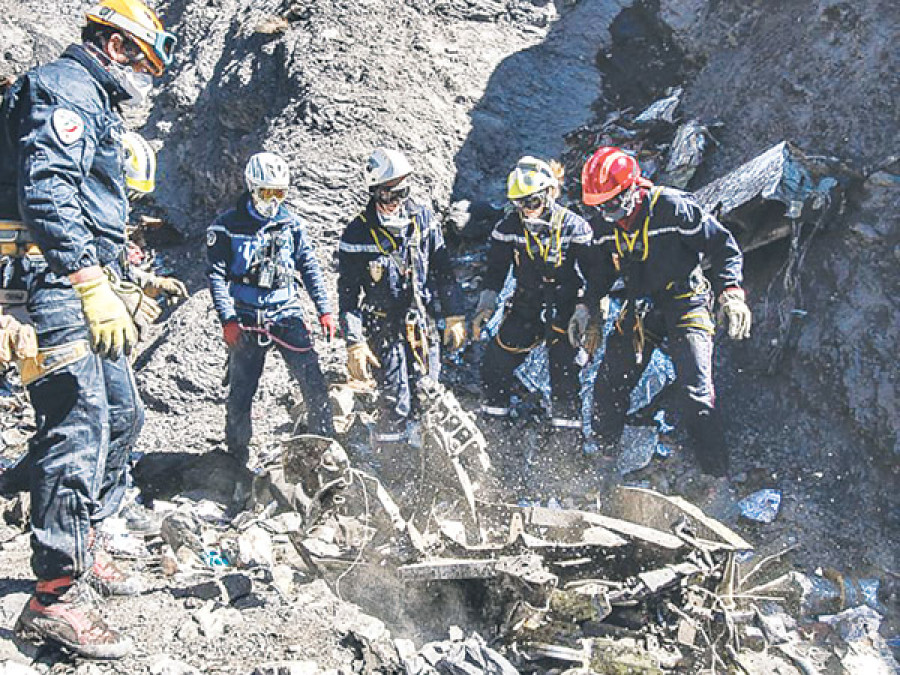Opinion
Entry denied
Crew members must be required to inform the airlines of their mental state and general health.
The Germanwings context
The Germanwings accident coverage was, and it still is to some extent, all over the media. It seems to have brought to the fore something that was never imagined possible. Securing the cockpit was primarily based on concerns following three meticulously planned and deliberately executed infamous accidents in 2001. But this time, the perpetrator was legitimately occupying the right-hand seat, waiting for an opportune moment.
This despicable act has raised fundamental questions about the core assumption on aviation safety itself. How could a fully bred-and-brought up ‘westerner’ be so irrationally dangerous? While Islamic terrorists are driven by misguidedly cruel motives, we can see nothing more than an
urge for self-destruction in this case. But the co-pilot was not alone; there were 149 other helpless souls behind the cockpit door. To fathom what goes in the depth of one’s brain is a very different but an equally difficult front to tackle. More so, as a determined person can easily camouflage his inner feelings.
Seen in this context, the fortified cockpit door did exactly what it was designed to do, as even the Captain could not break into it. Helpless as he was, the most he could do was to bang against it, pleading. The negative implication of such a fortified system was foreseen by some to have commented against this, right at its outset. A wholly new aircraft security system will now have to treat even cockpit occupants with suspicion. And, the cockpit door will now have to be made friendly to ‘good people’! But even that will not be a panacea, as what if all cockpit crews turn rogue? Equally, we cannot rule out other sinister combinations that might jeopardise aviation safety yet again in the future.
Continuing mystery
As in the case of the missing Malaysian Airlines MH370, both the Captain and his first office remain as suspects, given the unexplained change in flight direction and unwarranted switching off of the transponder. We have had many MH370 conspiracy theories in the absence of irrevocable evidence as to its fate. Elaborate theories have gone to the extent of showing satellite images with an imposed outline of a buried B777 in a remote location in Kazakhstan. Incidentally, it happens to be the Northern extreme, based on the calculation of Inmarsat ‘handshake’ data. Each handshake-based calculation provides two set of answers, one for the north and other for the south. The primary focus of the search, as is well known, continues to be the southern Indian Ocean region, as it is assumed that MH370 never headed north.
As for another lead, residents of a remote Maldives island have made written statements about seeing a “low-flying jumbo jet” in the early morning of March 8, 2014. We really do not know what to believe. While digging the suspected Kazakh grave site is, possibly, out of the question, the seas around the Maldives may already have been scouted by ships from big maritime nations, unannounced. We will learn a lot more about its mysteries only if the black boxes are retrieved, and that is a very big ‘if’, the wreckage will ever be found.
Incidentally, recordings, both audio and video, by airline passengers can be a major source to learn about the cabin environment just prior to the crash. While nothing can be superior to black box data, these small fragments can nevertheless be treated as complementary pieces of a jigsaw puzzle. If so, many of the preposterous MH370 theories can either be proved at best or falsified at worst. We are already hearing about cell phone recordings from the last few minutes of the Germanwings flight.
The analysis of the A320’s flight data recorder should eventually nail the German first officer. But the evidence remains circumstantial until a detailed FDR analysis is done. Same goes with the history of suicidal tendencies on the co-pilot’s part. It should be easy now, that the vital FDR has been found, even if badly deformed. The data storage chip/card seems to have survived the 700 km/hr terrain collision and is said to be readable.
Safety and security
The question is, will it be possible to design a backup system such that people with nefarious intentions will not ever be able to control the aircraft in flight. The good news is that such a system already exists and is known as ‘uninterruptible auto pilot’. It can be activated from the ground at the slightest hint of someone attempting to fiddle with the aircraft controls. The bad news is that it is not in general use, as adopting such a system is likely to create more problems than it can possibly solve. The biggest concern is the possibility of such an overriding system could leave the aircraft vulnerable to hacking. We may never get to point of it being made mandatory.
The most pragmatic solution will be to make it possible for airlines to be legally required to be informed about mental state and general health of each crew at even shorter intervals, if necessary. Germanwings co-pilot Andreas Lubitz was able to conceal his mental state from his employer quite legally, so to say. Health issues cannot be covered by a confidence clause, if the desire is to honestly stop deliberately-induced accidents from happening again. How can you have one without the other? For the sake of aviation safety, you simply must have both.
Arjyal writes extensively on aviation




 13.12°C Kathmandu
13.12°C Kathmandu









